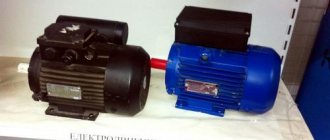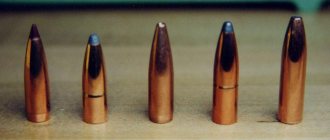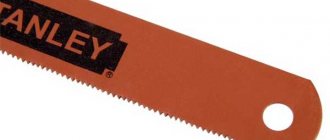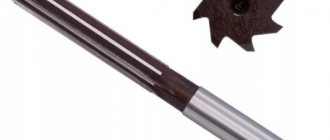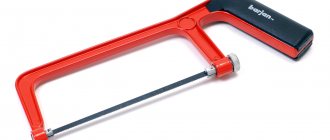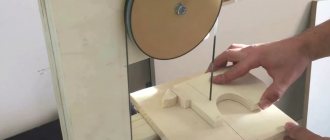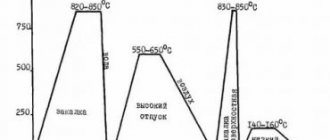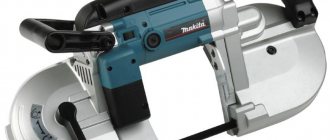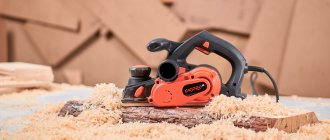Working with lumber in small volumes is a task that hand hacksaws and jigsaws can handle quite well. But what if you need to get maximum performance in minimal time? The obvious solution is to use hand-held circular saws, which, firstly, have sufficient power, and secondly, are distinguished by convenience and mobility, which are not characteristic of stationary sawmills.
We invite you to get acquainted with the classification and design features of circular saws for wood, as well as take a look at the rating of the most popular models of this year.
Marking
As you can see in the picture, the markings of the disc can tell about many technical properties. But there is a dependence that should not be ignored: the shape of the teeth directly affects the ability to work with a certain material.
The systematization developed by representatives of the GASS brand divides discs into the following categories according to the shape of the teeth:
GK and GS: alternately beveled. Suitable for processing all types of wood and “clean” chipboards, without plywood and plastic coatings.
GM: straight. They can only cope with cutting soft wood.
GT: trapezoidal. They will be needed in cases where it is necessary to cut MDF or chipboard with lamination.
GR: conical. Cuts multi-layer coatings with double lamination.
GA: trapezoidal and straight. Same abilities as GT.
Choosing the ideal saw blades for wood. Find out the characteristics of circular saw attachments.
It doesn't take much to purchase a reliable circular saw. Without good equipment, she will not be able to cope with the assigned tasks. Only the installation of high-quality saw blades will allow you to achieve the highest productivity when working on wood.
Number of teeth
As the number of teeth increases, the processing speed decreases, but the cleanliness of the cut improves. And vice versa: the fewer teeth, the faster the work goes, but the cut becomes less and less careful. The property has its own systematization, presented in the table:
| № | Name | Number of teeth, pcs |
| 1 | Huge | 80-90 |
| 2 | Average | 40-80 |
| 3 | Small | 10-40 |
External diameter
The outer or outer diameter of the disk should not exceed the dimensions of the circular saw casing, otherwise it will not be possible to install it at the landing site. Increasing the parameter leads to an increase in the depth of cut. The line varies from 65 to 500 mm.
Disc thickness
The standard parameter is 3.2 mm. The thinner the disk, the more it heats up and the faster it fails. The large thickness guarantees a long service life of the equipment, but slows down the work. In this case, the excess consumption of material increases due to the wide cut.
Landing diameter
Landing or internal diameter is the size of the hole in the center of the equipment. Determines whether the saw blade will fit on the spindle. The most popular sizes are: 16, 20, 22, 30 and 32 mm. But the full spectrum is even wider - from 11 to 50 mm.
Tooth sharpening angle
The sharpening angle is the angle of difference between the cutting edge of the tooth and the radius of the saw blade. The picture clearly shows how a trait can influence the work process. The angles are:
Standard: 5-15°. Universal sharpening. Suitable for all types of cuts.
Positive: 15-20°. Ideal for rip sawing due to the “grabbing” effect.
Negative: 0 to.5°. Used for cross cutting, does not form chips.
TOP 10 best circular saws
- Criterias of choice
- Design specifics
- Intensity of use
- Types of work performed, materials used
- Type of power supply
- Power
- Working disk rotation speed
- Working disk diameter
- Cutting depth
- Additional functionality
- The best circular saws
- Makita 5008MG
- Hammer CRP 900 A
- ELITECH PD 1600L
- Bosch GKS 190
- Interskol DP-190/1600M
- DeWALT DWE560
- Bison ZPD-1600
- BLACKDECKER CS1550
- Status CP190
- Kolner KCS 140/900
- Techniques and safety rules when using a circular saw
- Maintenance Features
Bosch GKS 190
Professional class electric circular saw with a powerful motor (1.4 kW). Depth of cut at right angles 70 mm, weight 4.2 kg. It is possible to connect a vacuum cleaner to remove sawdust and dust from the workplace. The saw operates with 190 mm discs, the mounting diameter is 30 mm. The kit includes:
- carbide disc ;
- 6-sided key;
- adapter for dust extraction.
- good power;
- equipped with a turbofan;
- ease of use due to the rubber pad;
- reliable casing ensuring safe operation;
- well-designed dust removal;
- changing the depth of cut and angle of inclination;
- comfortable long cord.
Disadvantage: unreliable attachment for the vacuum cleaner.
Sources:
https://obinstrumente.ru/elektroinstrument/cirkulyarnaya-pila/diski-dlya-cirkulyarnoj-pily.html https://stroy-podskazka.ru/shlifovalnaya-mashina/disk-po-derevu/ https://gadgetok.ru /top-luchshih-tsirkulyarnyh-pil.html
Classification of saw blades
Depending on the design features, the equipment is divided into 2 types:
Whole. The entire disc is made of tool steel. Its main advantages are its low price, the possibility of self-sharpening and maintainability - a large margin of durability.
Carbide. The base is made of tool steel, and the teeth are made of hard alloys with the addition of tungsten carbide. The main advantages are the highest hardness of the saw edge, a clean cut and a long interval between sharpenings.
Carbide-tipped discs allow you to do woodworking with the greatest speed and productivity, but they have a severe drawback - special tools and above-average abilities are required for maintenance.
READ Comparison of Husqvarna 365 and Shtil 361 chainsaws
Dust removal system and blowing away sawdust from markings.
Despite the fact that the disc moves from the bottom up and forward from the working one, the flow it creates is not enough to remove the resulting sawing waste, which obscures the visibility of the cut mowing line. The best circular saws have an integrated chip removal system. The air drawn in by the rotor impeller passes through the slots in the inner part of the casing and increases the flow from the rotating equipment. A dust collector bag can be installed on a number of models, but most have a pipe for a vacuum cleaner.
Circular saw for wood Yato YT-82154. Circular saw Sthor 79254. Circular hand saw for wood Storm WT-0614. Tilt angle adjustment mechanism.
From time to time you need an end that is not perpendicular to the surface, but made at an angle to it. You won’t get it by simply tilting the tool; the degree of tilt must not only be set, but also followed along its entire length. To do this, vertical semicircular posts with a slot for a lock are installed on the base plate on both sides. They include strips that connect the upper casing. The value is set steplessly or with quick adjustment (small recesses) of the angles more necessary during operation (0, 15, 22.5, 30 and 45 degrees). The perfectly executed mechanism does not go astray during operation after tightening . But accurate setting of the angle of inclination is not trusted to the factory markings, but rather inspected with a protractor.
Guide rail.
The plunge-cut saw moves along it in a straight line (parallel stops are not used). Some disk models are also capable of working together with guides. They can be easily distinguished by a groove running through the entire support frame, located on the opposite side from the saw blade. The tool is put on the bar from above, and is not inserted from the end. The size and geometry of the grooves of most guides are standardized and are suitable for devices from various manufacturers. Size range: from 0.36 up to 2.6 meters. The connection occurs with a replaceable butt plate.
Saw blade protection.
The upper protection cap on all models of electronic circular saws is cast from duralumin alloy. Metal will not crack like plastic if separated from a carbide-tipped disk rotating at a speed of several thousand rpm (user safety). It will maintain the integrity of the instrument even if it accidentally falls on a hard surface. And the gearbox, cast as a single blank with the gearbox housing, serves for its best cooling under the greatest loads, for example, sawing raw wood.
The lower part of the equipment is covered by a movable spring-loaded fence, which always strives to return to position and does not give the user access to the teeth of the disk. Before work, the master fixes the board on the trestles and turns on the circular saw. Holding it with both hands, he brings it to the cutting line for cutting. Places the base plate on the surface and simply pushes the device forward. When pressed, the slightly curved front part of the lower casing moves away, exposing the saw blade. The movement of the tool is created from itself, forward, and the material is snatched from the upper surface of the workpiece. Upon completion of the cut, the fence will automatically close under the action of a spring, protecting the carpenter from accidental contact with the equipment.
Who selects the saw blade for a certain type of circular saw. When choosing one, you should take into account the power of its motor, the spindle rotation speed, and the diameter of the landing pin. A circular saw blade with a high number of revolutions and teeth at a negative angle will put a huge load on the engine. If you should, be sure to find out what the capabilities of your saw are. It is also worth keeping in mind that no matter what kind of saw has a landing diameter, therefore the disk must correspond to its dimensions. Choosing a saw blade requires attention to such information as the series of the blade, its design and external size, and the diameter of the mounting hole.
What kind of disks are there?
In production and everyday life, different types of disks are used. They differ from each other not so much in the material of production, the position of the teeth, but also in the scope of use. Our client can of course divide the products exhibited on the financial market into 4 types:
Models used when working with brick, tile, granite and hard materials. The cutting edge of such products is often diamond-tipped, which allows you to quickly handle any material of any density. There are products on the market for wet cutting and dry cutting. The main feature of dry saw blades is the presence of cooling holes and a segmented edge. When using a saw with such a blade, it is imperative to take breaks so that the attachment cools down. Wet saw blades have no teeth and are soldered all over the edge. The diamond layer can reach 5.5 mm in height. Such equipment is used in the professional field for long-term use. Cooling occurs due to the supplied water.
myth type of product is used when working with lumber or other solid wood. As a rule, they also differ, however, in the operations they perform. There are discs of this type for quick cutting of wood. They differ from others in the small number of teeth, which are produced by a rough cut. There are also products in the field for clean cutting, on the edges of which there are many small teeth for longitudinal cutting with large teeth. If the cut is meant to be made across the workpiece, then use a disk with small teeth. Universal products are considered to have both small and large teeth on the edges. They will help you do
any woodworking without changing the disc.
This model is used to perform work with metal, including pipes, profiles, fittings, etc. These metal saw blades differ in the type of material that they will process. If a disk is used in a saw design without liquid cooling, then there will be slots in its body, which will replenish the pumped temperature.
This equipment is used when working on plastic, fiberglass or metal-plastic. The teeth on such products have a negative sharpening angle, so careful cutting is performed even on small parts. Some equipment of this type is used as a disc on laminate, chipboard or fiberboard.
During work, sharp equipment must be used. Otherwise warped and dull discs become a prerequisite for jamming in the product, and, accordingly, blocking the motor.
How to sharpen?
Just like another tool, a saw
needs timely care. The most crucial moment is sharpening the circular saw blades. Experts note that the carbide tooth wears out along the main top edge; if massive workpieces are sawed, then the side edges also wear out quickly. The saw should not be allowed to become too dull, as it will be less productive, and it is not a fact that the discs can be sharpened.
READ How to Make a Winch From a Chainsaw
Proper sharpening involves simultaneously ensuring the proper sharpness of the cutting edge. If you sharpen them along one front plane, the number of sharpenings will be less. Many owners of similar tools are interested in how to sharpen a circular saw blade. This varies depending on the material of the teeth. Sharpening is almost always done on a wheel made of CBN, also called green carbide, otherwise based on diamond wheels. It is advisable to use CBN wheels when sharpening saws made of high-speed steel, and diamond wheels for sharpening cutters made of hard alloys. To sharpen quickly, but have less impact on the degree of wear, it is worth choosing diamond wheels with a larger grain size.
For sharpening, machines that have different functionality are also used. The most complex and expensive models provide automatic sharpening. When sharpening, you should separate the teeth: if this is done incorrectly, then during the cutting process there will be a burning smell, extraneous noise, and the material itself will move jerkily, which is not very comfortable.
You should constantly monitor the condition of the disks, since their wear will increase the load on the mechanisms and at some point lead to complete wear. Thanks to constant sharpening, it is natural to extend the life of the equipment, improve productivity and reduce the time for the cutting process. If after sharpening the cut remains sloppy and the material moves unevenly, then you should pay more than just attention to the location of the teeth.
How to choose saw blades? This is easy to do if you follow a few rules:
- Find out the diameter of the mounting hole and the outer diameter of the blade on the label - you need to meet the requirements of the features of your saw.
- Pay attention to the thickness of the disc: thin ones provide a good and clean cut and are used when working with valuable types of wood, while thick ones are advisable to use for preparatory cutting of materials.
- The disk will indicate what the very permissible number of revolutions is. A low speed of revolutions will allow you to develop a higher cutting speed, but will lead to deformation of the disk and a poor saw.
- Evaluate the quality of the saw blade: if it is good, then the cutting plane will be smooth, without roughness or imperfections.
B – pay attention to safety and choose saw blades that are designed for a specific type of saw. And additionally, think about where to sharpen the circular saw blade if you are not able to do this at home.
Types of saw blades
What remains for our client to do? Saw blades are divided into two types:
- Solid ones are created from solid metal and are distinguished by sharply ground teeth. They are popular due to their affordable prices, the possibility of restoration, in other words, re-sharpening. On the other hand, solid products wear out faster.
- Carbide disks for hand-held circular saws are more reliable and durable, since they are equipped with sharpened cobalt or tungsten carbide tips on the teeth. With the use of carbide materials, products are more durable and reliable, however, if the discs become dull, it will be difficult to return them.
Service
Of course, this is only a small part of the high-quality models presented on the modern market. The search for the ideal power tool is an eternal search for a compromise between power, workmanship, reliability, the availability of additional options and the price of the device.
It is important to remember that hand-held circular saws for wood are high-precision electrical devices that require appropriate care and maintenance. The device must be protected from moisture, especially network models.
Cordless saws can be used in damp areas, but not outdoors during precipitation. Over time, it may be necessary to clean the housing from accumulated sawdust, which impairs engine cooling, as well as lubricate the mechanical components of the gearbox. Consistent substances like “Solidol” are well suited for this.
Do you use a circular saw?
Constantly! I want to try
Before each new use, remove sawdust, resins and other contaminants from the working surface of the disk with liquid reagents, then wipe dry with a clean rag.
Discs should be replaced immediately after detecting the first signs of damage to the teeth - if you continue to work with a faulty disc, you can not only ruin the cut, but also cause serious injury.
It is acceptable to sharpen dull teeth, but if you do not have experience with a sharpening tool, it is better to entrust this to a professional.
Expert opinion
Kuznetsov Vasily Stepanovich
We hope our tips were useful and helped you understand all the subtleties and nuances of choosing a circular saw and working with it. Use caution and caution when using any power tool. Good luck!
Circular saw tanto.Production process and end.
A knife from a circular saw. The saw had a mark on it made in our country and GOST numbers. GOST steel grade 9хф, and this.
You should choose a saw blade for a circular saw taking into account the type of cut - you will prefer it to be transverse or longitudinal. Already now, the materials you intend to cut also play an important role - wood , plastic, chipboard, non-ferrous metals, pipes... Let us note one thing - it does not matter which series of discs is designed specifically for certain jobs.
The quality of the blade directly affects the cutting efficiency. A good canvas is created by laser cutting, while balancing is done on a computer. Grinding of each disc is done separately. A high-quality blade will reflect sanding tool marks in the light. If the blade is rough and looks roughly processed, such a circular saw blade will not work efficiently and will become dull faster.
READ How to Start a Gasoline Saw Sturm Qc 99371b
What types of circular saw blades are there, and how to choose them correctly?
Circular saws or circular saws are hand-held tools that can be used to make transverse and longitudinal cuts in various materials. The main design element of such a tool is an iron disk with cutting teeth on the sides. Systematization of saws What remains for our client to do are the circular saws exhibited on the economic market are divided according to their purpose. Among them:
- Models used for metal cutting
- Used for cross-cutting wood
- Wood rip saws
- Models used for cutting panel materials, including laminate
It doesn’t matter which circular saw may belong to models of different cutting depths. Among the enormous assortment offered by manufacturers, four types stand out:
- Small saws with a cutting depth of 4 to 4.6 cm
- Average cutting depth with a distance of 5-5.5 cm
- Large cutting depth
from 6.5 to 7 cm - Professional saws with a cutting depth of 6.5-14 cm
Important Features
So that readers do not get lost in the wilds of the modern market for accessories for circular saws, we have prepared 5 main criteria that will help make their choice. Let's look at them in order of importance.
Disc thickness
The standard parameter is 3.2 mm. The thinner the disk, the more it heats up and the faster it fails. The large thickness guarantees a long service life of the equipment, but slows down the work. In this case, the excess consumption of material increases due to the wide cut.
Circular saws for wood
A circular saw is a rotating cutting tool in the shape of a round blade with an abundance of cutting teeth around the perimeter, which is designed for mechanical cutting of wood and wood-based materials.
The circular saw is made of alloy tool steel, with heat treatment, leveling, calibration, setting and sharpening.
- Material: The circular saw is made of 75Cr1 steel. (DIN 1.2003); (ČSN 19418)
heat treatment: The circular saw is hardened to 44-48 HRc for body thickness up to 3 mm and to 42-46 HRc for body thickness over 3 mm.
- leveling: When leveling a circular saw, differences in the flatness of the surface are eliminated, i.e. so that the axial (face) runout of the circular saw does not exceed:
- values 0.2 mm for circular saws with a diameter of up to 200 mm
- values 0.4 mm for circular saws with a diameter of up to 500 mm
- values 0.6 mm for circular saws with a diameter of up to 800 mm
- values 0.8 mm for circular saws with a diameter greater than 800 mm
- sharpening: For sharpening circular saws, we can recommend a grinding wheel made of snow-white or grayish corundum, medium grain size and hardness, with a porous or very porous structure with a clay or bakelite base. A circle with clay binder material is designated:
- A99 60L 9V (snow white)
- A96 60L 9V (grayish)
- Overheating of cutting inserts: manifested by a change in the color of the tips of the cutting inserts, which occurs due to overheating of the material during sharpening. Overheating can occur due to very enormous pressure (removal of a huge amount of material) of the grinding wheel on the surface being sharpened, due to the introduction of a very hard grinding wheel, very small grain size of the grinding wheel, incorrect fastening of the tool, or intense sharpening without cooling.
The runout of the circular saw changes when clamped near the mounting hole, and you need to pay attention to the quality of the clamping flanges, which must have a diameter of at least 5x√D of the saw.
calibration: By properly adjusting the preparatory load, the strength of the circular saws is increased, which makes it possible to increase the feed rate and thus improve the cutting accuracy and quality of the cut surface. During manufacturing, circular saw blades are calibrated for a cutting speed of 60 m/sec for the smallest thickness and 80 m/sec for the thickest circular saw blade. Proper speed at which you saw
calibrated, indicated on the circular saw.
routing: The amount of routing (on one side) is usually 1/4 of the thickness of the disk body. Only the upper third of the tooth is moved apart. The wiring must be symmetrical, otherwise a circular saw
begins to deviate towards a larger distribution.
The layout is always done before sharpening; after sharpening it is only controlled and corrected if necessary. When using a very small setting, the circular saw overheats, loses strength and moves to the side. With an extremely large setting, losses appear from a very wide cut, greater energy consumption and increased roughness of the cut surface. For soft wood we choose a larger layout than for hard wood. For longitudinal cutting we choose a larger layout than for cross cutting. For wet wood we choose a larger layout than for dry wood. For a frozen tree, we choose a smaller layout than for an unfrozen tree. If the machine is in poor condition, we choose a huge layout.
The most common reasons for short sharpening times:
Sources:
https://e-1.com.ua/catalog/display/category/1/subcategory/7 https://instrument16.ru/instrument/pily/marka-stali-diskovoj-pily-po-derevu.html https: //www.pilana.com/ru/tekhnicheskaya-informatsiya-dlya-diskovykh-pil-iz-instrumentalnoy-stali
